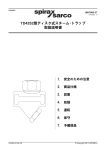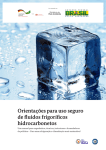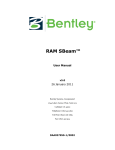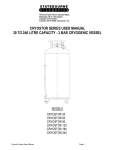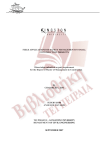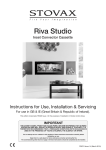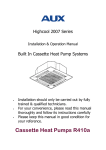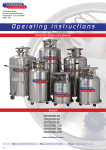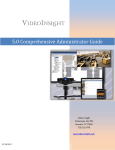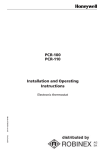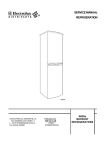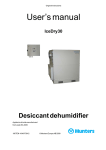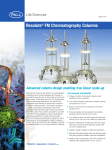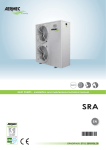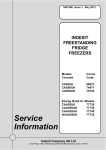Download Guide to Good Commercial Refrigeration Practice Part 4 System
Transcript
Guide to Good Commercial Refrigeration Practice Part 4 System Installation British Refrigeration Association Institute of Refrigeration Issue 1 October 2008 Guide to Good Commercial Refrigeration Practice Part 4 System Installation CONTENTS 4.0.0 GENERAL 4.1.0 OPERATIVES RESPONSIBILITIES. 4.1.1 SITE RULES. 4.1.2 SITE CONDITIONS. 4.1.3 PROGRAMME OF WORK. 4.1.4 WORKMANSHIP. 4.1.5 LIAISON WITH CLIENT/ CO‐CONTRACTORS. 4.1.6 SITE REQUIREMENTS. 4.2.0 HEALTH & SAFETY REQUIREMENTS. 4.2.1 RISK ASSESSMENTS AND METHOD STATEMENTS 4.2.2 GENERAL SITE SAFETY. 4.2.3 SAFETY IN WORKING WITH OXY‐ACETYLENE BRAZING OR WELDING EQUIPMENT 4.2.4 SAFETY IN PRESSURE TESTING. 4.2.5 SAFETY IN HANDLING REFRIGERANTS. 4.2.6 WORKING IN HAZARDOUS AREAS. 4.2.7 SAFETY REQUIREMENTS FOR UNLOADING AND POSITIONING OF PLANT AND EQUIPMENT. 4.2.8 SAFETY IN POSITIONING OF ELECTRICAL EQUIPMENT. 4.2.9 SAFETY REQUIREMENTS FOR DRAINAGE. 4.3.0 LOCATIONS AND POSITIONING OF PLANT AND EQUIPMENT. 4.3.1 GENERAL DETAILS. 4.3.2 SETTING DOWN PLANT AND EQUIPMENT. 4.4.0 PIPEWORK ROUTING ARRANGEMENTS. 4.4.1 ROUTING OF PIPEWORK 4.4.2 PRESSURE EQUIPMENT DIRECTIVE (PED) 4.5.0 PIPEWORK INSTALLATION. 4.5.1 LEAK PREVENTION 4.5.2 COPPER TUBING. 4.5.3 COPPER TO COPPER PIPEWORK FITTINGS. 4.5.4 COPPER ‐ FLARE AND THREAD FITTINGS. 4.5.5 COPPER ‐TYPES OF JOINT. British Refrigeration Association 2 Institute of Refrigeration Guide to Good Commercial Refrigeration Practice Part 4 System Installation 4.5.6 COPPER ‐INSTALLATION OF LINE COMPONENTS. 4.5.7 COPPER ‐ PIPEWORK SUPPORT METHODS FOR COPPER PIPEWORK. 4.5.8 COPPER ‐ METHODS OF CUTTING TUBES. 4.5.9 COPPER ‐ PIPE OR TUBE BENDING. 4.5.10 COPPER ‐ BRAZING OF PIPEWORK. 4.5.11 PIPEWORK INSULATION. 4.5.12 STEEL & STAINLESS STEEL PIPEWORK. 4.6.0 ELECTRICAL INSTALLATION WORK. 4.6.1 CABLES AND WIRING SYSTEMS. 4.6.2 MAIN SUPPLIES. 4.6.3 INTERCONNECTING WIRING AND CABLE ROUTE. 4.6.4 CABLE SIZING AND VOLTAGE DROP. 4.6.5 EARTHING AND TESTING. 4.7.0 CONDENSATE DRAINAGE. 4.7.1 CONDENSATE SYSTEM AND MATERIALS. 4.7.2 GRAVITY DRAINAGE. 4.7.3 PUMPED CONDENSATE DRAINAGE. 4.8.0 PRE‐COMMISSIONING SYSTEM TESTING AND PREPARATION. 4.9.0 DRAWINGS 4.10.0 APPENDICES British Refrigeration Association 3 Institute of Refrigeration Guide to Good Commercial Refrigeration Practice Part 4 System Installation 4.0.0 4.1.0 4.1.1 GENERAL The appearance of the refrigeration installation engineer/operative and their attitude to clients, colleagues and co‐contractors, is of great importance in presenting the image of a company. He/she should present themselves in a pleasant manner ensuring they are wearing clean and tidy work‐wear at all times. Users of company vehicles should ensure these are kept in a clean and tidy condition. OPERATIVES RESPONSIBILITIES ON SITE SITE RULES Installation Operatives are responsible for: • • • 4.1.2 4.1.3 obeying any site rules and safety regulations that may be in force ensuring the safety and tidiness of their work area for using in a safe manner any personal protective equipment or safety equipment that has been made available for their use. working with safety as a prime consideration at all times • SITE CONDITIONS All working areas are to be kept clean tidy, only sufficient materials for the work in progress at the time are to be allowed in the working area. Other materials are to be stored in a safe area agreed with client/principal contractor. Prior to hand over, operatives should ensure that their working areas have been cleaned and tidied to a reasonable standard. All debris etc. should be removed from site or deposited in designated areas on site. Particular attention should be paid to plant room plenum chambers, the tops of coldrooms/coldstores, and the undersides of display cases. Care should be exercised with the disposal of waste materials and substances, see the Environmental Protection Act 1990, Duty of Care, section 34, and the company’s waste disposal procedures both which should be complied with. PROGRAMME OF WORK Installation operatives should ensure they are familiar with the programme of works agreed with client/principal contractor, for which they are responsible. They should make every effort to ensure the programme is maintained. Operatives will be required to give progress reports as and when required by their manager or the project engineer. British Refrigeration Association 4 Institute of Refrigeration Guide to Good Commercial Refrigeration Practice Part 4 System Installation 4.1.4 4.1.5 4.1.6 In the event of major unforeseen problems on site, the engineer should contact their management immediately to ensure difficulties are dealt with quickly and efficiently. Operatives should record and report to their manager any verbal on site instructions given by the client/principal contractor. WORKMANSHIP Operatives should be qualified and competent, able to demonstrate that all work is carried out to the best of their ability and in accordance with the guidelines laid down in these procedures. LIAISON WITH CLIENT / CO‐CONTRACTORS Contact with the client, principal contractor, or the other co‐contractors should be maintained at the highest levels by the company’s personnel. SITE REQUIREMENTS Site operatives must ensure that the following requirements are maintained at all times: • Contact client or principal contractor when first arriving at site. • Sign in and out of site on a daily basis. • Keep client/principal contractor informed of your work programme and safety requirements which may affect other people. • Do not work in a manner which may affect the health and safety of you and/or that of other workers, or members of the general public. • Report any accident or incident to your supervision and to the client/principal contractor, and see that details are entered in Site Accident Book and Company Accident Book. • Do not use, or interfere with, any malfunctioning work equipment; report it to your supervisor so that it can be replaced. • Compliance with Permits to Work e.g. hot works, fire alarm isolation, electrical isolation, restricted access, etc • Maintain a site diary including a H&S file covering attendance record, site induction record, induction of risk assessments record, H&S training and any Tool box talk records British Refrigeration Association 5 Institute of Refrigeration Guide to Good Commercial Refrigeration Practice Part 4 System Installation 4.2.0 4.2.1 HEATH AND SAFETY REQUIREMENTS RISK ASSESSMENTS & METHOD STATEMENTS For all site work to be completed by operatives, risk assessments and method statements covering activities required and substances to be used are to be completed and submitted within the site safety plan prior to commencement of any work. All operatives should be inducted so fully understand the requirements and able to comply with the site safety plan. For guidance refer to British Refrigeration Association’s publication “Task Procedures and Risk Assessments 4.2.2 GENERAL SITE SAFETY Certain safety rules apply to all sites, some of the more important ones, but not all of them, are: • Operatives should wear or use appropriate Personal Protective Equipment at all times while they are on site. • Work areas should be kept in a tidy condition and all hazards removed as far as practicable. Where any hazards remain, a risk assessment should be made and control methods employed to reduce the risk e.g., safe systems of work, safety signs etc. If certain work processes are going to affect others working in the area, they should be advised and, if necessary, the area cleared before work is allowed to commence. • Permits to Work. In certain areas where hazardous situations can arise, a system known as a “Permit to Work” may be required. Operatives should be aware of this requirement and check with the site management before commencing work in any of the following situations: (i) Working at height, (ii) Work involving hot work, (brazing). (iii) Working with abrasive wheels. (iv) Working with hazardous substances, (where this may affect others in work). (v) Working in confined spaces. (vi) Working on live electrical equipment. Further details on Permits to Work can be located in the British Refrigeration Association’s publication Task Procedures and Risk Assessments. Permits to work are usually administered by the client or principal contractor. It is prudent to train operatives to be able to administer a self‐raising permit allowing them, and the client or principle contractor to sign, particularly when small work is involved and/or site British Refrigeration Association 6 Institute of Refrigeration Guide to Good Commercial Refrigeration Practice Part 4 System Installation 4.2.3 management does not have a permit system in place. Some Contractor’s company warranty insurance may become invalid if permit is not in place prior to commencement of work. • Safe storage of materials and equipment. Before work has commenced on site, arrangements should be made with the client/principal contractor for the storage of materials to be used for the installation, together with any work equipment which may be used. Hazardous chemicals, gases, etc. need to be stored in a secure, well ventilated area away from the normal working areas of the site. Only sufficient materials for the work in progress should be maintained within the work area. Likewise any hazardous materials or equipment should be removed from the area at the end of the working day. SAFETY IN WORKING WITH OXY‐ACETYLENE, BRAZING OR WELDING EQUIPMENT Oxy‐Acetylene equipment presents many safety problems if not used or maintained properly. Following are the requirements for satisfactory use and operation: • Cylinders to be secured to a purpose built trolley mounted in a vertical position, when in use. • Equipment should be visually checked at the beginning of each working day for damage, malfunction and leaks etc. • Anti‐flash back arrestors must be fitted to equipment at all times and changed every 5 years. • Do not use lines longer than are necessary to reach inaccessible work areas, (assess if the cylinder trolley can be moved to a nearer location). • Use appropriate Personal Protective Equipment including heat resistant gloves, goggles and arm protection, as necessary. • Ensure adequate ventilation to the work area. If necessary additional ventilation must be made available. • Check that suitable fire precautions are taken and that fire extinguishers are available ready for use. • Purge both oxygen and acetylene lines before lighting up. • Always uncoil lines fully, do not coil excess hose around cylinders or regulators. • Move cylinders only using an appropriate trolley. Never transport cylinders with regulators and hoses attached unless on a purpose‐designed trolley or carrier. British Refrigeration Association 7 Institute of Refrigeration Guide to Good Commercial Refrigeration Practice Part 4 System Installation • • • • 4.2.4 4.2.5 During carriage of cylinders by road. Ensure all concerned are aware of which gases are being carried and which are flammable, toxic or corrosive by displaying appropriate safety signs. Ensure that relevant safety data, TREM Cards and COSHH sheets are carried for each type of gas or substance. This information must be available in an emergency and visible in the driving compartment. Make sure cylinders are properly loaded and secured so that they cannot move about. Ensure all gauges and lines etc, are removed. Do not smoke or ignite flammable materials. Oxy‐acetylene equipment is subject to examination annually by a competent person. SAFETY IN PRESSURE TESTING The main safety requirements for the pressure testing of refrigeration systems are: That access to the area where the testing is being carried out should be restricted to the personnel concerned with the testing. Oxygen Free Nitrogen (OFN) used for the testing must be introduced into the system via a steel braided hose. (Demanded on the majority of construction sites giving resistance to kinking and damage by possible third parties) Any pressure gauges used for reading the system pressure must be fitted remote from the charging line, (no refrigeration lines to be used for charging the OFN). In addition to system integrity pressure testing there is a requirement for leak tightness testing. This is usually carried out with lower pressures. The distinction between the two tests is covered in section 4.8.0. A good practice guide is the IOR Service Engineers Guide 24 – Leak Tightness Testing. For further guidance and compliance refer: BS EN 378‐2:2008 'Pressure Requirements and Pressure Vessels’ ‐‐ BRA Task Procedure Risk Assessment R10 covering Pressure Testing of Refrigeration Pipe‐work Systems ‐‐ HSE GN4 Safety in Pressure Testing ISBN0717616290. SAFETY IN HANDLING REFRIGERANTS The deliberate venting of refrigerants to the atmosphere has been prohibited since 1990, under the terms of the Environmental Protection Act. This is because of the affect that HFC’s and other refrigerants have on Global Warming and Ozone Depletion. This has led to the introduction of the Safe Handling of Refrigerant Assessments for operatives installing, servicing and maintaining refrigeration equipment and systems. It is a legal requirement that all operatives handling HCFC and HFC refrigerants are trained and their competence demonstrated by obtaining C&G 2078, (At appropriate time through UK legislation C&G 2078 will be superseded by C&G 2079) or CITB qualification. All operatives with one of these qualifications should then register with ACRIB (Air British Refrigeration Association 8 Institute of Refrigeration Guide to Good Commercial Refrigeration Practice Part 4 System Installation 4.2.6 4.2.7 4.2.8 Conditioning, Refrigeration Industry Board) to allow Clients and End‐Users access to check credentials It is highly recommended that operatives do not handle any refrigerant including hydrocarbon, carbon dioxide, or ammonia without proper training and the ability the demonstrate competence WORKING IN HAZARDOUS AREAS As previously mentioned in 4.2.1, working in hazardous areas usually requires a Permit to Work system. Operatives should check before commencing work to see if such a system is required. Further information on working in hazardous areas can be found in the British Refrigeration Association's Task Procedures and Risk Assessments. SAFETY REQUIREMENTS FOR UNLOADING AND POSITIONING OF PLANT AND EQUIPMENT. Before delivery of the main items of refrigeration equipment for a project, a thorough site survey needs to be carried out to ensure both a safe and level area is available for unloading to take place, and clear unobstructed routes can be found to the final positions where the equipment is to be installed. Where lifting operations to high levels are required, these are normally carried out by a mobile crane (usually hired for the occasion). The responsibility for the operation and movement of the crane rests with the operator, but the user/hirer needs to assure themselves that all the appropriate regulations and codes of practice are being complied with. Crane operator should make available prior to commencement of work a completed Risk Assessment with method statements The final positioning of equipment (e.g, refrigeration packs, condensing units, condensers, cabinets, etc.) often comes down to manual handling by a team of workers. Care should be exercised at all times if injury is to be prevented. It is important that all members of the team understand how and when to lift. Risk Assessments with method statements should be completed prior to commencement of work, for further information of lifting operations refer to the BRA Task Procedures and Risk Assessments. SAFETY IN POSITIONING OF ELECTRICAL EQUIPMENT During the design stage of the project, in order to allow sufficient access for servicing and maintenance purposes, thought must be given to the positioning of items of equipment such as packs, electrical control panels. The Electricity at Work Regulations requires a minimum of 1 metre clear space to the front and the sides for persons working on live electrical equipment. British Refrigeration Association 9 Institute of Refrigeration Guide to Good Commercial Refrigeration Practice Part 4 System Installation 4.2.9 4.3.0 4.3.1 SAFETY REQUIREMENTS FOR DRAINAGE Again at the design stage it must be ensured that a suitable drainage system is available in which to discharge the condensate from evaporators. This applies particularly to refrigerated cabinets using secondary refrigerants. These require a special drainage system, where filters and scrubbers prevent discharge of pollutants into the sewage system. LOCATIONS AND POSITIONING OF PLANT AND EQUIPMENT GENERAL DETAILS In many cases the location of the refrigeration plant for a project will have already been decided before commencement of work on site. It is the designer’s responsibility under CDM Regulations to assess the situation and to stress to the client his responsibilities under Health & Safety Law (e.g., PUWER: 1998, CDM: 2007, and the Health & Safety at Work Act: 1974, etc.). Account should be taken of any access problems which may arise for maintenance, service and decommissioning, noise problems when plant is running, also the plant or equipment must have adequate ventilation and weather proofing. In the case of “small works”, where a designer has not been employed, or the work does not fall within the requirements of CDM: 2007, the “Installation Engineer” may be required to select the locations/positions for such items as condensing units, air cooled condensers, pumps, control panels etc., and agree these with the client. The following good practices are recommended: • Care must be taken to ensure condensing equipment is sited in a well ventilated area with adequate weather protection. • Do not site condensing equipment in roof wells. In hot weather these will form a heat trap and effect the operation of the equipment (e.g. high head pressure and nuisance tripping of HP switch). • When choosing the location and position of refrigeration and air conditioning equipment, thought needs to be given to access for service and maintenance purposes. E.g., how can heavy items, such as compressors, be brought in and out? Is there enough space around the equipment for a person to work safely? Too often end users want equipment to be installed where service technicians are placing themselves in hazardous situations in order to carry out service of maintenance operations. Reference to CDM Regulations and the Health & Safety at Work Act is recommended. • Adequate weather protection must be provided, either in the form of individual housings or purpose built plant rooms, for packs or racked condensing unit systems. Further information on this can be found in Section Two ‐ Design. British Refrigeration Association 10 Institute of Refrigeration Guide to Good Commercial Refrigeration Practice Part 4 System Installation 4.3.2 4.4.0 4.4.1 SETTING DOWN PLANT AND EQUIPMENT Refrigeration equipment needs to be set down on adequate surfaces or fixing points, to prevent problems of noise, vibration, and leakages of refrigerant at a later stage in the life of the plant. The following points need to be observed to achieve this: • Bases should be constructed from concrete wherever possible, and have a smooth and level surface on which the equipment is to sit. • If equipment is to be situated on a wooden floor, insulation material such as cork or fire retardant composite board should be placed between the equipment and the floor. • Wherever possible, it will be an advantage to supply and fit proprietary anti‐ vibration mounts. • Where equipment is situated on cantilever wall brackets, ensure that the construction of the wall is such that it will support the weight of the brackets and the equipment. • In outside locations, the surface of the base needs to be raised above ground level by at least 100 mm to prevent flooding in storm conditions. • Wherever possible, equipment should be fixed firmly to the surface on which it is located. Equipment situated at height (i.e. on wall brackets), should always be fixed in order to prevent movement. PIPEWORK ROUTING ARRANGEMENTS ROUTING OF PIPEWORK The route of the pipework between the evaporator and the condensing unit or compressor, and remote condenser, should be as direct and as short a distance as possible. All pipework should be designed and installed to give liquid and oil a “drain” flow with no traps. Traps should only be used to obtain oil entrainment in vertical risers. Traps and bends which can create pressure drops in the system should be kept to a minimum. Consideration should be given to allow for expansion in long lengths of discharge line. Distortion due to expansion can cause working of joints at the connection points leading to refrigerant leaks Wherever possible, pipework should utilise “pulled” bends and sets using patented mechanical tube bending equipment. The use of manufactured elbows produces greater pressure drops when the system is operating. British Refrigeration Association 11 Institute of Refrigeration Guide to Good Commercial Refrigeration Practice Part 4 System Installation 4.4.2 4.5.0 4.5.1 4.5.2 PRESSURE EQUIPMENT DIRECTIVE (PED) Pressure Equipment Directive (PED 97/23/EC) covers a number of areas with regard to refrigeration and air conditioning piping and vessels. Engineers may require assessment qualifications to be able to complete brazing e.g. BRA – Jointing of Copper Pipework for Refrigeration Systems, or equivalent/better alternative. Refer paragraph 4.5.9 PED requires systems operating with 0.5 bar and greater, that design processes and site work methods demonstrate compliance with the regulations and hence the safety pressures declared for that system. Dependent upon the system declared safety pressures and into which category of certification this fall, there may be a requirement for elements of design and site work methods to be assessed and approved by a “Notifiable Body”. These are organisations that are responsible for setting standards or auditing to standards such as insurance companies’ e.g. Lloyds or in standards, BSI. Design documentation and site work instructions should state if the system is subject to Notifiable Body attendance to audit and approve compliance PIPEWORK INSTALLATION LEAK PREVENTION F‐Gas Regulations 842/2008 details requirements for refrigerant containment. Pipework and component installation is a major process where following recommended industry good practice in conjunction with current codes and regulations should give a system that is at least risk to leak. Specifications and processes along with reference to codes and regulations are covered in the following paragraphs with the aim of achieving a leak tight system COPPER TUBING With the introduction of refrigerants that operate at higher pressures care is necessary when considering the strength of the copper tube to be used. Design documentation should show tube sizes with wall thickness and these should be checked prior to commencing installation. To conform to EN378:2008 the majority of copper tube suppliers now label tubing by marking to the external surface or the tubing is supplied certificated. For practical help to ensure the correct pipe wall thickness is used for the appropriate refrigerant two guides are available with selection tables: 1) BRA Fact finder no7 A Guide to Selecting Copper Tube and Fittings for New Refrigeration and Air Conditioning Systems. 2) IOR Service Engineers’ Section Datasheet no 4 Copper Pipe Wall Sizing and New Refrigerants Copper tube used for refrigeration systems must conform to the following specifications: BS EN12735‐1 These specifications cover seamless (Refrigeration & Air Conditioning Grade) copper tubing in soft, half hard, and hard tempers, it is normally available sizes listed below (all based on Outside Diameters ‐ OD):‐ British Refrigeration Association 12 Institute of Refrigeration Guide to Good Commercial Refrigeration Practice Part 4 System Installation Soft Drawn 1/8”, 3/16”. 1/4”, 3/8”, 1/2”, 5/8”, 3/4”, 7/8” ‐ in 6 metre and 15 metre coils. Half Hard Temper 3/8”, 1/2”, 5/8”, 3/4”, 7/8”, 1 1/8”, 1 3/8”, 1 5/8”, 2 1/8” ‐ in 3 metre and 6 metre lengths. Hard Temper 2 5/8”, 3 1/8”, 3 5/8”, 4 1/8” ‐ in 3 metre and 6 metre lengths. All refrigeration grades copper tubing is marketed as clean, dehydrated and sealed at the ends. COPPER TO COPPER PIPEWORK FITTINGS U U U 4.5.3 4.5.4 4.5.5 There are several ranges available. Again these fittings are manufactured specifically for the refrigeration industry and are based on OD sizes. These fittings are used to join various lengths and sizes of copper tube together, thus forming the pipework system. The method of joining is by manual flame brazing. These fittings conform to ASME D16.22.‐1995. Types of fittings are:‐ • Long Radius Elbows • Short Radius Elbows • Tee Pieces (Equal and reducing) • Couplings (Equal and reducing) • Reducing Elbows • 45° Elbows • Caps • Return Bends • “P” Traps COPPER ‐ FLARE AND THREAD FITTINGS For the smaller sizes of soft drawn pipework a range of brass flare fittings are available. The use of these should be kept to a minimum due to their susceptibility to leakage of refrigerant and the effects this has on the environment. These fittings conform to SAEJ513. COPPER ‐ TYPES OF JOINT There are many ways of joining copper pipework for refrigeration systems. Some of the more common ones are listed and explained here: British Refrigeration Association 13 Institute of Refrigeration Guide to Good Commercial Refrigeration Practice Part 4 System Installation • Flared Joint: These joints should only be used where other means of jointing are impractical due to the weakness of this type of joint and the environmental impact of refrigerants. This is achieved by the use of a flare nut for the respective size of pipe (1/4” OD, 1/2” OD, etc.) being slipped over a prepared end of copper tube. The end of the copper tube is then flared outward to an angle of approximately 45°. The flare nut is then connected to a flared fitting or component, forming a vapour proof joint. • Swaged Joints: Swaging of joints in copper pipework permits two pieces of tube of the same diameter to be joined together without the use of fittings, it being more convenient to braze one joint than two with the use of connectors and improves risk against leakage. Less joints, less leaks, containment being the major requirement of the F‐Gas regulations. To achieve a swaged joint, one piece of tubing is swaged out to the outside diameter of the other piece. As a general rule the length of overlap should equal the outside diameter of the tube. Generally the use of swaged joints in copper pipework is acceptable, however on the larger sizes there is a possibility of thinning the wall of the tube, thereby leading to problems of leakages later. Therefore the maximum size of pipe where swaging is acceptable is 1 5/8". All pipework above this diameter shall be joined using standard copper‐to‐copper couplings. Two types of swaging tools are commonly used; the punch type for smaller diameter tubes and the mechanical expander type. With both types, different tool sizes are available for use with the many sizes of copper tubing. The swage is then brazed to achieve a leak proof joint. See also Section 10 sub‐section 29 relating to pulled tees. • • 4.5.6 Flanged Joints: Where pipework has to bolt onto items of equipment, such as compressors, a flange joint is used. The actual joint being formed by a gasket which sits between the two flanges, thus forming a leak proof joint. The jointing of the copper pipework to the flange is achieved by brazing. Lok‐Ring: Brass Lokring fittings are now available to suit refrigeration and air conditioning pipework up to 7/8”. Designed for working pressures up to 50 bar and therefore a preferred acceptable alternative to brazing particularly in locations where hot works is prohibited COPPER ‐ INSTALLATION OF LINE COMPONENTS Before any components are fitted into a refrigeration system it is important that the installer understands where within the system they have to be fitted, the correct methods to be used to fit them and the correct orientation for satisfactory operation. Further information on various components of the refrigeration system can be found in Section 2. British Refrigeration Association 14 Institute of Refrigeration Guide to Good Commercial Refrigeration Practice Part 4 System Installation 4.5.7 COPPER ‐ PIPEWORK SUPPORT METHODS FOR COPPER PIPEWORK Numerous methods of fixing have been developed over the years because of the many situations in which refrigeration pipework is installed.. It is important to survey the site thoroughly before work on site commences. This enables the route for the pipework be established with others (e.g., Client/Co‐contractor etc.) and the methods of fixing confirmed. All piping should be adequately supported, the supports or hangers being sized to carry the weight of the pipe including the contents, and where required the insulation. The recommended distance between supports is as follows: COPPER PIPE SIZES MAX, SPACING OF SUPPORTS (mm) (inch) (m) 15‐22 1/2 ‐ 7/8 soft drawn 1 22‐54 1/2 ‐ 2 1/8 half hard 2 54‐67 2 1/8 ‐ 2 5/8 half hard 3 Pipework for installation may involve routing through floor ducts or fastened to walls or ceiling, or at high level on supports suspended from roof purlins or rafters. Following are recommended methods of fixing for the various situations. • Floor Ducts: Where ducts have been formed to take the refrigeration, electrical or plumbing services to a refrigerated fixture, or group of fixtures, there is normally no need for clipping or fixing of pipework. It is laid in the bottom of the duct resting on load bearing insulation materials. Care needs to be taken to ensure that the pipework does not foul the corners of the ducts, or the other services where crossovers of these occur. Cradles need to be made in order to prevent chaffing. Where ducts hold a number of pipes and double stacking is necessary, load bearing insulation needs to be placed between the layers of pipework. • Fixing to Walls and Ceilings: If pipework has to run up or down a wall, or traverse a ceiling, several methods of fixings are available as follows:‐ a) Pipe clips: Where pipework for a single system is involved, the suction and liquid lines are fixed directly to the wall by means of pipe saddles clamping over each of the pipes. As most suction lines are insulated, a saddle that is slightly smaller than the outside diameter of the insulation needs to be selected. This enables the pipework to be held satisfactorily, with only a slight indentation of the insulation material. b) Cable Trays: The use of cable trays allows for a tidy fixing of pipework, particularly where a large number of pipes have to be run. The tray, which can be obtained in standard sizes from 50 mm up to 60 mm, is fixed to the British Refrigeration Association 15 Institute of Refrigeration Guide to Good Commercial Refrigeration Practice Part 4 System Installation wall or ceiling with a spacer between the tray and the surface. The pipework, and/or electrical services, are then clipped to the tray by means of special nylon ties. Again, care must be exercised in fixing suction lines to ensure insulation around the pipe is not distorted, and the vapour seal is not broken. The advantages of using cable tray are that it gives the installation a tidy, professional look, and enables the vapour seal on suction lines to be maintained by gluing the lengths of insulation end on end. It is important that where exposed copper pipework is run on galvanised cable tray some means of insulating the pipework from the tray is used. This prevents electrolytic action and corrosion. c) Proprietary Fixing Systems: There are a number of fixing systems available. These systems are very adaptable and can be used to fix or support single or multiple pipework systems, whether fixed to a surface or suspended from rafters or purlins. The pipework is fixed by means of insulated clamps to support brackets cut and assembled on site to suit the particular requirements. 4.5.8 4.5.9 Reference should be made to suppliers’ literature for fixing materials and insulation for further information. COPPER ‐ METHODS FOR CUTTING TUBE To cut copper tube either a hacksaw or tube cutters may be used. Wherever possible tube cutters should be used, the tubing should be cut squarely (90°). After the tubing has been cut the ends of the pipe must be reamed and scraped, in order to remove any sharp burrs on the inside and ends of the tube. If tube cutters are unavailable or inappropriate and a hacksaw has to be used, a wave set blade of 32 teeth per inch is recommended. It is important that filings or chips of any kind do not enter the pipework. Whenever pipework is left with an exposed or unconnected end it needs to be sealed with a suitable cap to prevent the ingress of moisture, dust etc. COPPER ‐ PIPE OR TUBE BENDING As explained in 4.4.1, wherever possible, refrigeration pipework should have any bends or sets formed by means of mechanical tube bending equipment, this makes for a neater, more professional installation and reduces the possibility of pressure drops when the system is working. There are several brands of mechanical tube bending equipment ranging from the smaller hand held lever type (sizes 1/4” ‐ 5/8” OD), to the larger hydraulically operated (sizes 7/8” OD ‐ 2 1/8” OD). In order to achieve a consistent high standard of bends and sets in pipework, requires skill, accuracy in measurement and lots of practice. If a bend is not formed satisfactorily the British Refrigeration Association 16 Institute of Refrigeration Guide to Good Commercial Refrigeration Practice Part 4 System Installation 4.5.10 work may have to be done again (i.e. stretching of the wall of the tube, under or over estimating the distances in which the pipework has to fit). This leads to increased cost in both material and labour, therefore the following rules apply: • Measure very accurately the distance between the centre of the joint into which the pipework is going to fit, and the position where the outside of the bend is going to finish; add an extra half diameter of the pipe size to this measurement (1 1/8” OD pipe extra to measurement 9/16”. Line up this measurement with the outside edge of the former. Carry out the forming of the bend, the pipework with the bend(s) formed should accurately fit into the space measured. • To aid the forming of bends and sets, lightly oil the slipper of the bending equipment. This will help prevent ripples and scoring of the tube. COPPER ‐ BRAZING OF PIPEWORK Brazing is one of the best methods of joining together refrigeration pipework, it produces strong, leak free joints, which stand up to the most extreme temperature conditions. Only suitably qualified personnel should undertake brazing, e.g. holders of BRA Brazing Assessment or CITB Assessment or an appropriate NVQ including this activity with assessment. Oxyacetylene brazing equipment provides the best means of achieving this with the combined mixture of pure oxygen and acetylene producing a very hot flame (no less than 600°C). Brazing can be done relatively easily if the correct procedures are followed: • Thoroughly degrease and clean parts and joints to be brazed. • Support all parts and ensure the joints fit closely. • Apply flux recommended for the brazing alloy, (if a flux is required). Follow the manufacturer’s instructions. • Heat the joint evenly to the recommended temperature. Keeps the torch moving constantly in a circular motion. • Apply the brazing alloy to the heated joint, do not melt the alloy with the torch. • Allow the joint to cool. • Clean the joint thoroughly, using warm water and a brush. Ensure all flux is removed. British Refrigeration Association 17 Institute of Refrigeration Guide to Good Commercial Refrigeration Practice Part 4 System Installation 4.5.11 4.5.12 • Pass oxygen free nitrogen (OFN) through the pipework being joined while the brazing operation is taking place, this will reduce the scale build up on the inside of the pipework. • Use only brazing filler alloys which comply with EN 1044. A more detailed guide to the brazing of refrigeration pipework may be found in the BRA “guide to the joining of copper pipework for refrigeration systems”. The person carrying out the brazing procedure must have an appropriate brazing assessment qualification, a legal requirement within the European F‐Gas regulations, and either be or be supervised by a person holding an F Gas qualification i.e. C&G 2079 or CITB equivalent PIPEWORK INSULATION All suction and hot saturated vapour defrost pipework must be fully insulated with the correct sized insulation material in order to prevent ice and condensation forming on the pipework. When the pipework has been successfully pressure tested, the joints in the insulation may then be glued together using an adhesive recommended by the manufacturer. STEEL & STAINLESS STEEL PIPEWORK General Carbon, Carbon Manganese, low alloy and Austenitic stainless steel pipe and fittings are regularly used within the refrigeration industry in particular for industrial ammonia systems. These materials correctly applied offer a robust pipe work system with high pressure integrity and are compatible with most refrigeration applications. Unless purchased in large quantities these materials are not available with the same level of cleanliness as found in refrigeration quality copper tube. Further processing such as acid pickling or abrasive blasting should be employed to remove the residue from manufacturing processes such a mill scale, protective lacquers and oxides. Where this is not practical the introduction of additional serviceable filters with valves as appropriate should be considered. Materials The material specification and grade shall be chosen with regard to the lowest temperatures either in operation or at standstill. The specification and wall thickness should be determined in accordance with an appropriate National or International standard such as BS EN 14276‐ Part 2 Pressure equipment for refrigerating systems and heat pumps. Piping. General requirements. Traceability of steel pipe and fittings can be achieved by the recording of their markings. These cast or heat numbers should then be cross referenced to the material test certification to verify that the materials are in compliance with the specification and grade. Test certificates should be to level 3.1B of BS EN 10204 Metallic materials.‐Types of B British Refrigeration Association 18 Institute of Refrigeration Guide to Good Commercial Refrigeration Practice Part 4 System Installation inspection documents. Welding consumables that form part of the pressure containment envelope should also be controlled by batch number and supplied with certificates of conformity from the manufacturer. Stainless Steel Whilst stainless steel offers good low temperature ductility and corrosion resistance, it does distort, more than carbon steels, due to welding stresses and if these residual fabrication stresses are high they will cause stress fractures, particularly in thin wall materials. Also the process operating conditions and environment should be checked for certain corrosive elements such Acids, chlorides, bromine, cupric ions, ferric ions, sulphide ions etc that may cause corrosion. Dissimilar materials. Special consideration needs to be given to the possible combinations of dissimilar materials, their joining techniques and their operating environments. To prevent electrolytic action between reactive materials such as some grades of stainless steel and copper/brass a eutectic break should be considered. If joined by brazing the alloys of the brazing material will also have to be considered to avoid the elements leaching out of the joint by electrolytic action. Brazing and/or welding procedure specifications and qualifications were appropriate should identify the material combinations applicable. Pipe Connections The number of joints should be kept to a minimum and fusion welded joints used in preference to flanged or screwed connections. Welded Joints Welding should be carried out so far as practical in a controlled environment such as a workshop and if practical strength tested prior to final assembly on site. In situ ‘positional welds’ should be kept to a minimum and their location considered at the design stage to ensure adequate access for welding, cleaning, and inspection including non‐ destructive testing (NDE). As with all hot work extra care should be taken to remove flammable materials from the work area, task risk assessment carried out and cooling down (fire watch) periods observed. Joint design. Preference should be shown for multi‐pass full penetration butt‐welded joints due to their superior fatigue and brittle fracture resistance. Fillet welds should be avoided for low temperature and or cyclic service. Due to the difficulty of fabricating and achieving good joint geometry and distortion free welds, size on size, off‐set and tangential branch welds should be avoided unless special process conditions require their use. Proprietary weld fittings should be used where possible; these should be to an applicable standard such as BS 1640‐1:1962 Specification for steel butt‐welding pipe fittings for the petroleum industry. Wrought carbon and ferritic alloy steel fittings or equivalent. B B B British Refrigeration Association 19 Institute of Refrigeration Guide to Good Commercial Refrigeration Practice Part 4 System Installation Welded end caps to BS EN 10253‐2:2007 should also be used for the termination of pipe and in particular headers. Where this is not possible the end closure should be formed from a material to an appropriate specification and it’s thickness calculated in accordance with PD5500: 2006 Specification for unfired fusion welded pressure vessels. The use an appropriate NDE technique should be considered to check the weld quality. Socket weld fittings to BS 3799:1974 Specification for steel pipe fittings, screwed and socket‐welding for the petroleum industry up to DN40 can assist in achieving correct pipe alignment and prevent contamination where access or site conditions are adverse. Weld Procedure Specifications An appropriate documented procedure should be produced to detail the material group (s) being joined, size range, joint geometry and tolerances, welding parameters and consumables specifications. Were either by contract or regulation these should be qualified by a United Kingdom Accreditation Service (UKAS) approved third party to an appropriate standard such as BS EN 15614‐1:2004 Specification and qualification of welding procedures for metallic materials. Welding procedure test Welding Operator Qualifications The welding operators competence should also qualified where required either by contract or regulation these should be qualified by a UCAS approved third party to an appropriate standard such BS EN 287‐1:2004 Qualification test of welders. Fusion welding. Steels. The extent of the qualification (s) should cover the range of materials, welding positions diameter range, welding process and wall thickness and checked that the validity has not time expired. Welding Processes Gas Tungsten Arc Welding (GTAW), sometimes referred to as TIG, Shielded Metal Arc Welding (SMAW) Oxyfuel Gas Welding (OGW) and Gas Metal Arc Welding (GMAW) sometimes called MIG are all commonly used. Care should be taken to efficiently remove flux and spatter expelled during the welding process. For single sided full penetration welds the GTAW (TIG) process should be considered to minimise the build up of oxides on the second side (inside) of the pipes. Stainless Steel, and elsewhere if required by the welding specification, will require an appropriate shielding gas to be purged thought the inside of the pipe to prevent unacceptable internal oxidisation and root weld defects. Detachable Joints, Flanges Flange materials and bolting should be appropriate for the temperature either in service or at standstill. Steel flanges should comply with BS EN 14276‐2 Bolting should be to BS EN 1515‐1:2000 Flanges and their joints. Bolting. Selection of bolting or PD 5500:2006 Gaskets, Flange gaskets should meet the requirements of BS EN 378:2008 and checked for compatibility with the refrigerant and lubrication oils used. B B B B British Refrigeration Association 20 Institute of Refrigeration Guide to Good Commercial Refrigeration Practice Part 4 System Installation Pipe Threads Taper threads should be restricted to DN40 and used to connect control, safety and indicating devices. The fittings should of the correct pressure rating to an applicable standard such as BS3799 Any sealing medium used should must be check with the manufacture for compatibility with the refrigerant and lubricating oils used. Threaded coupling welded to pipe should be checked for distortion and their threads chased out as appropriate. Small diameter < DN10 threaded fittings are vulnerable to damage from weld spatter and over tightening and care should be taken not to strip their threads. Steel Pipe Supports and Hangers All piping shall be adequately supported, the supports or hangers being designed to carry the weight of pipe including its contents and, where required, insulation. Particular attention should be paid to pipe work that could operate full of liquid. The distance between supports depends on the size and service weight of the pipeline: a recommended maximum spacing for steel pipes is as follows: B B Steel pipe sizes DN 15‐25 32‐50 65‐80 100‐175 200‐350 400‐450 Max. Spacing of supports Horizontal Vertical run run (m) (m) 2 2.4 3 3.0 4.5 4.6 5 4.6 6 8.5 7 20.0 4.6.0 ELECTRICAL INSTALLATION WORK GENERAL Refer BS EN378‐3:2008 Section 6 “Electrical Installation”, and British Refrigeration Association Fact Finder No 11 titled “Identification of Electrical Conductors in Fixed Installations” Electrical work for the larger refrigeration installations (e.g. supermarkets, large coldstores, industrial installations), is usually carried out by an electrical contractor using qualified electricians to install the wiring systems. However, in some “small works” the installation engineer may be called upon to carry out the interconnecting wiring installation from the fused isolator (provided by the client) to the various components of the refrigeration system. It is important that the person carrying out this work understands the rules and regulations of BS 7671: 2008 IEE Wiring Regulations, commonly known as 17th edition; and the Electricity at Work Regulations 1989, and that the electrical installation is inspected and tested by a qualified and competent electrician before the power is switched on. British Refrigeration Association 21 Institute of Refrigeration Guide to Good Commercial Refrigeration Practice Part 4 System Installation 4.6.1 An inspection completion certificate must be issued to the client on completion of the works. Accreditation of the contractor to the NICEIC (National Inspection Council for Electrical Installation Contracting) is recommended but not essential. CABLES AND WIRING SYSTEMS This section identifies the types of cable and wiring systems suitable for use with refrigeration equipment. It must be remembered that some of them are not suitable for locations where the temperatures are constantly below 0°C, for example conduit, and trunking systems. • Steel Wire Armoured Cable (SWA): Suitable for most applications except in locations constantly below 0°C. This cable manufactured to BS 6346 is in common use within the refrigeration industry and is preferred wherever possible both from the cost and suitability points of view. The method of fixing is by means of clipping direct to the surface or clipping to the cable tray, the cable is terminated using the appropriate glands for connection into the various components. SWA can be purchased in a variety of cable sizes and cores (1.5 mm2 to 95 mm2 and 1 core to 19 cores are the most popular sizes). • FP200 Fire Resistant Cable: This cable was developed primarily to offer improved protection against fire and heat damage, allowing it to be installed in high temperature locations and where there is a requirement for essential services. However these properties lend themselves to refrigeration applications, particularly in situations where the temperatures are constantly below 0°C (i.e., connection to evaporators and other components within a coldroom/coldstore). This is mainly because of the butyl rubber insulation covering the cores; the outer protection being made of plastic coated aluminium. This type of cable is generally available in sizes 1.0 mm2 ‐ 2.5 mm2 and with a number of cores from 2+ECC (Earth Conducting Core) to 4+ECC. Fixing is by means of clips, either direct to a surface, or fastened with nylon cable ties to the cable tray. On no account is the cable to be strapped to any refrigerant lines. Termination ferrules are available for connecting to equipment. • Conduit Systems: There are four types of electrical conduit system: a) PVC ‐ High impact b) Steel ‐ Galvanised c) Steel ‐ Stainless d) Steel ‐ Black enamelled The steel versions are not recommended for locations which give rise to humidity or where the temperatures are constantly below 0°C, for reasons previously mentioned in this guide. British Refrigeration Association 22 Institute of Refrigeration Guide to Good Commercial Refrigeration Practice Part 4 System Installation Available in standard tubing sizes of 20 mm, 25 mm and 32 mm (OD), comes a variety of fittings such as pipe saddles, bends, adaptors, reducers, tees and circular boxes. All these enable the conduit wiring systems to be adapted and fitted into the installation. On completion of the conduit work, suitably interconnecting wiring is drawn through the pipework and connected to the various electrical components. This cable usually comprises of “single core” PVC or Butyl rubber insulated conductors. • Trunking Systems: Like conduit, trunking is available in PVC, galvanised steel, stainless steel and enamelled steel. Galvanised steel being the one in most common use. However, plastic trunking may be preferred for humid and corrosive atmospheres. Sizes are normally available in 1” to 6” plastic, and 2” to 6” steel. Trunking is appropriate where several electrical items are installed (e.g adjacent control panels) with numerous cables converging (either from above or below) from the various parts of the refrigeration system. The final connections with the individual components being made with conduit or SWA etc. • Other Forms of Electrical Wiring: These are less frequently used in refrigeration electrical works. a) b) c) Flexible concentric insulate copper braided cable CY type. This cable has been used mainly in Europe but is becoming more available in the UK. It is particularly useful in situations where movement is necessary, as with connection to moving machinery. However, check the manufacturer’s specification before installing it in situations where temperatures are constantly below 0°C. It is available in sizes 0.75 mm2 to 2.5 mm2 and with 3 to 18 cores. Concentric PVC insulated steel braided cable SY type. As with the copper braided type mentioned above, this cable has been used mostly in Europe. With its steel braiding it is particularly suitable for locations where there is a possibility of impact damage. As with the fabric braided type or fixed with the special clips supplied by the manufacturer, it can also run in trunking. The cable is terminated into the components by means of cable glands, giving a water proof‐dust proof connections. Available in sizes 0.75 mm to 6.0 mm and with 2 to 16 cores. PVC insulated cable is not recommended for refrigeration purposes, it is mostly used for domestic installations. British Refrigeration Association 23 Institute of Refrigeration Guide to Good Commercial Refrigeration Practice Part 4 System Installation 4.6.2 4.6.3 4.6.4 MAINS SUPPLIES It is important at the design stage for the correct electrical power supply details and required loading to be established. An area that is often overlooked at the outset of a project is the checking that there are sufficient available incoming supplies to meet those required for the new equipment to be installed. Plus to ensure there is a provision for the new supply to be brought to the position where the refrigeration equipment is to be installed. There are three main types of electrical power supply available in the United Kingdom. a) 400 V + 10% ‐ 6% 3 Phase 50 Cycles b) 400 V + 10% ‐ 6% 3 Phase and Neutral 50 Cycles c) 230 V + 10% ‐ 6% Single Phase 50 Cycles It should be noted that the voltage references will be ± 10% from January 2003. All electrical supplies contain an earth. Ensure that the equipment being installed will operate on one of these supplies. INTERCONNECTING WIRING AND CABLE ROUTES The mains power supply is usually run to the condensing unit or pack position, terminating in either a control panel mounted on the plantroom wall, or directly into the electrical section of the refrigeration or air conditioning equipment. From these panels interconnecting wiring is fed out to the various items of equipment making up the refrigeration system. In some instances, two separate power supplies are provided. One to operate the condensing equipment, and the second to operate the cooling/evaporator section; this may be situated a considerable distance away. With this arrangement interconnecting wiring is not required, (system designed with facility to pump down). In both cases it is important to ensure that the final sub circuits are protected by fuses of the appropriate rating and where necessary with local “lock off” isolation to protect the engineer safely when completing service or maintenance work. CABLE SIZING AND VOLTAGE DROP The dual purposes of sizing cables properly, is to: (a) ensure that the temperature of the conductor’s insulation does not exceed the temperature for which it was designed when carrying its rated current carrying capacity. British Refrigeration Association 24 Institute of Refrigeration Guide to Good Commercial Refrigeration Practice Part 4 System Installation (b) 4.6.5 to prevent an excessive drop in the voltage applied to the equipment to which it is connected. The current carrying capacity of the conductor is based on there being no obstruction to the flow of heat from the conductor, thus an equilibrium is reached, and the conductor maintains a steady temperature. Full information on the current carrying capacity and voltage drop can be obtained from Appendix 4 of BS 7671: 2008 (IEE Wiring Regulations) 17th Edition. EARTHING AND TESTING Regulation 8 of the Electricity at Work Regulations requires precautions to be taken to ensure that any conductors of electricity which may become charged as a result of either, use of a system, or a fault in a system, do not present a danger to persons or property. The most commonly used method of achieving this is by means of earthing. It is the practice in the UK for the Public Electricity Supply System to be referenced to earth by a deliberate electrical connection made at sub stations or power transformer. It is this means of “system earthing” that enables earth faults on electrical equipment to be detected and the electrical supply to be cut off automatically. In order to ensure safe system earthing the following factors must be observed: • Electrical bonding of exposed conductive parts of refrigeration equipment and their connection to earth services to limit the shock risk from transient voltages appearing between various components in the system. Equipment earthing therefore encompasses the bonding of metallic enclosures, cable armouring, conduits, trunking etc., so that these conductors are electrically, continuously and securely connected to the general mass of earth at one or more points. • Equipotential Bonding: It is essential that all exposed extraneous conductors which may become electrically charged from a fault on refrigeration equipment are also connected to the main supply earthing system. • Inspection and Testing: Before new installations or extensions to existing installations are put into operation they must be inspected and tested upon completion to verify that the requirements of the Electricity at Work Regulations and BS 7671: 2008 (IEE Wiring Regulations) 17th Edition have been satisfied. Guidance on Inspection and Testing may be found in Part 7 of BS 7671: 2008. On completion of the inspection and testing process, forms as required by the regulations must be completed by a qualified and competent person in respect to the design, construction, and inspection and testing of the installation. British Refrigeration Association 25 Institute of Refrigeration Guide to Good Commercial Refrigeration Practice Part 4 System Installation 4.7.0 4.7.1 CONDENSATE DRAINAGE GENERAL To ensure satisfactory disposal of condensate from refrigeration equipment, a properly designed and fitted plumbing system must be installed. This is an area that often does not get sufficient design consideration and inadequate condensate systems have been installed. Care has to be taken to avoid fixing condensate pipework close to refrigeration pipework with the possibility of the pipes becoming frozen and blocked at some stage. If there is no alternative route away from the refrigeration pipes, then the condensate pipework must be insulated. Since there is a possibility of sludge building up in the pipework (dust particles and other objects), the largest size of pipe should be chosen. If blockages and drain problems are to be avoided where pipework is run within the refrigerated space, it must be insulated with a refrigeration grade insulation. On installations where the temperature is 0°C and below, a proprietary type of heater tape needs to be wrapped around the condensate pipework prior to fitting the insulation. The type of heater tape used should be one which is permanently “on”, therefore supplying a constant heat to the pipework. At the design stage, notice should be taken of any local bye laws or regulations, particular site conditions, and requirements for final connections into the mains drainage. CONDENSATE SYSTEMS AND MATERIALS Copper and plastic are the two main types of material from which condensate drainage systems are constructed. Details are as follows:‐ • Copper: Copper tube and fittings manufactured to British Standard BS 2871 are available in 3 metre and 6 metre lengths in nominal bore sizes from 15 mm through to 159 mm. Fittings are available for sizes 15 mm ‐ 108 mm in both solder joint and compression joint. Pipework in installed using normal plumbing methods including bending of pipework by mechanical tube bending equipment. • Plastic: Plastic plumbing systems currently provide the most common method of installing pipework for condensate drainage. It has several advantages over other forms, e.g., costs, non corrosiveness, and ease of assembly. There are several proprietary types on the market, all manufactured to a British standard. Each type has three main methods of jointing as follows:‐ a) Solvent Weld: This is perhaps the best method utilised, provided care is taken with the preparation of the joint before applying the solvent. Pipework is joined by applying solvent to the ends of the pipe and inserting this into the appropriate fitting i.e., socket, bend etc. British Refrigeration Association 26 Institute of Refrigeration Guide to Good Commercial Refrigeration Practice Part 4 System Installation The solvent bonds the two surfaces together forming a strong water tight joint. A standard range of fittings and adaptors is available in nominal bore sizes from 19 mm ‐ 50 mm, all manufactured to BS 5254. b) c) 4.7.2 4.7.3 Compression: This type of joint utilises a knurled nut and rubber collar which fits over the pipe. The pipe is first inserted into the socket of the appropriate fitting, with the knurled nut then tightened onto the threaded portion of the fitting. The rubber collar is compressed between the nut and the fitting forming the water tight joint. A standard range of fittings and adaptors is available in nominal bore sizes 32, 40, 50 mm. Push Fit Ring Seal Type: This form of joint relies on the neoprene ring seal forming a water tight joint when the pipe end is inserted into the socket of the fitting. Standard. fittings are available in nominal bore sizes 32, 40, 50 mm. Use of this plumbing system is not recommended for refrigeration applications because of the susceptibility to movement, and the weakness of this type of joint,. GRAVITY DRAINAGE This method of condensate drainage depends upon the fall or slope of the pipework away from the equipment and is the most commonly used. This is particularly important where there is restricted space (i.e., under refrigerated cases). When installing a gravity drainage system some thought needs to be given during the design, to dismantling for cleaning and maintenance purposes. Pipework also needs to be fixed at appropriate points so that low points are not allowed to form. Finally the connection into the mains drainage system must be “trapped” just before the connection. PUMPED CONDENSATE DRAINAGE There are numerous arrangements, from collection pans fitted with float switches which control the operation of a pump to small self contained pumps (with electronic sensors) which can be fitted directly into the air handling unit: • The pipe or tubing used on this type of installation is of a small diameter, usually between 6 mm and 12 mm nominal bore depending on the application and the size of the pump. It is normally made from clear polythene, is very flexible, and is supplied in standard 50 metre bundles. A more expensive type is available where nylon braiding is laminated into the polythene tube to give more strength and less susceptibility to kinking. Preferable condensate drainage tubing is Black plastic that excludes daylight and hence discourages growth of slime inside, however is not always available in the size/s required. British Refrigeration Association 27 Institute of Refrigeration Guide to Good Commercial Refrigeration Practice Part 4 System Installation • • • 4.8.0 Where condensate pipework is to be connected into mains drainage system, a tun dish which is connected into the mains drainage via a trapped gravity pipework arrangement should be provided. A separate electrical supply (independent from the supply to refrigeration equipment) should be installed for the condensate pump to allow the condensate to be pumped away should the refrigeration electrical supply be interrupted. Any condensate drainage installed in coldrooms operating below 0C will require trace heating PRE‐COMMISSIONING SYSTEM TESTING AND PREPARATION System testing and preparation must be included in the installation program and at an early stage there must be determination whether or not to complete these tasks in phases, may be due to access or requirement for part system start up, or at the end of all installation work. These tasks shall be prior to the commencement of the commissioning stage and putting systems into service. System testing shall cover pressure testing for mechanical strength and leak tightness test to permit detection of leaks. Components, e.g. compressors, condensers, evaporators, pressure valves, safety valves and control gear, which have been previously strength tested by a manufacturer need not be subject to a further strength test. Manufacturer’s certificates should be obtained and included to system and operation manuals. Strength tests will normally be carried out before a leak tightness test, using oxygen free nitrogen (OFN) or other inert gas. Oxygen, air, ammonia, fluorocarbons, combustible gas or any combustible mixture shall not be used as a strength test medium Refer to design documentation for details of pressures to be achieved with time periods for the mechanical strength and leak tightness test. These shall comply with BSEN378:2008. If there is a need to complete a leak tightness test prior to strength test to confirm system or part system integrity this test shall be completed at very low pressure, say 5% of design. The leak tightness test shall be carried out with oxygen free nitrogen (OFN) or a mixture of OFN and a tracer. The tracer should be zero ODP and low GWP. Mixtures of HCFCs or HFCs with air should not be used All joints shall be checked for leaks using either a leak detecting bubble spray or an electronic leak detector suitable for use with the tracer. Following satisfactory testing, test certificates shall be completed and included to system operation end user manual. British Refrigeration Association 28 Institute of Refrigeration Guide to Good Commercial Refrigeration Practice Part 4 System Installation The BRA Task Procedures & Risk Assessments cover the following tasks to be completed prior to commencement of commissioning and system start up:‐ • A strength and leak pressure test must be carried out on the entire system. See task procedure and risk assessment R10 and R14. • A vacuum drawn on the whole system including condensing unit, pack etc to at least 2 mm HG. See task procedure and risk assessment R9. • The correct grade of refrigeration oil should be added as required according to the manufacturer’s instructions for the compressor, oil separator, and oil control system, where fitted. See task procedure and risk assessment R15. • The vacuum should be broken by charging the system with the correct refrigerant for that particular application. See task procedure and risk assessment R6. For further guidance on strength pressure and leak tightness testing refer to BSEN 378 1:2008 and BSEN 378 2:2008. In addition refer to the IOR Safety Code for Refrigerating Systems using A1 Refrigerants which is a comprehensive guide bringing together a number of regulations and directives that should be complied with. Leak tightness pressure test to permit detection of leaks and then demonstrate system integrity to contain refrigerant, along with refrigerant charging, reclaiming, leak detection methods including labelling and records shall comply with the F‐Gas regulations No 842/2006. Refer to BRA Code of Practice for Refrigerant Leak Tightness published 2007 for a comprehensive interpretation of regulation into practice. 4.9.0 DRAWINGS Please refer to 'Section 4 Drawings' which is at the back of this document. Drawing titles are:‐ ‐ Liquid Distribution ‐ Header Method ‐ Liquid Distribution ‐ Ring Main Method ‐ Liquid Distribution ‐ Reducing Method ‐ Liquid Trap ‐ Swaged Joints ‐ Standard Brazing Equipment 4.10.0 APPENDICES Acknowledgement of References, Standards and Legislation ACRIB Air Conditioning, Refrigeration Industry Board BRA British Refrigeration Association HU British Refrigeration Association UH 29 Institute of Refrigeration Guide to Good Commercial Refrigeration Practice Part 4 System Installation CITB C&G IOR NICEIC TREM UKAS BRA Documents Code of Practice for Refrigerant Leak Tightness in compliance with F‐Gas regulations – issue 1. Model Statements of Task Procedures and Risk Assessments for Commercial Refrigeration – issue 3. Jointing of Copper for Refrigeration Systems – issue 2. Fact Finders, Good Practice Guides. IOR Documents Safety Code for Refrigerating Systems using A1 Refrigerants. Service Engineer Guides Regulations CDM – Construction (Design & Management) 2007 COSHH ‐Control of Substances Hazardous to Health 2002 Electricity at Work 1989 Environmental Protection Act 1990 Environmental Protection (Control of substances that deplete the ozone layer) F‐Gas 842/2008 Health & Safety at Work Act 1974 PSS ‐Pressure Systems Safety Regulations: 2000 PED – Pressure Equipment Directive 97/23/EC PUWER – Provision and Use of Work Equipment GN4 – Safety in Pressure Testing guidance note Standards BS EN378:2008 parts 1/2/3/4, Refrigerating Systems and Heat Pumps – Safety and Environmental requirements. BS EN 12735‐1:2001 Copper Tube for Air Conditioning & Refrigeration. BS 3799 – 1974 Specification for Steel Pipe Fittings, Screwed & Sockets. BS EN 10204:2004 Metallic Materials. BS EN 14276‐2:2007 Pressure Equipment for Refrigerating Systems and Heat Pumps – Piping. BS EN 287‐1:2004 – Approval Testing of Welders for Fusion Welding. Construction Industry Training Board City & Guilds qualifications. Institute of Refrigeration National Inspection Council for Electrical Installation Contracting Transport Emergency Card United Kingdom Accreditation Service British Refrigeration Association 30 Institute of Refrigeration Guide to Good Commercial Refrigeration Practice Part 4 System Installation BS EN 10253‐2:2007 Butt Welding Pipe Fittings. Non Alloy & Ferritic Alloy Steels with Inspection Requirements. BS EN 15614‐1:2004 Specification and Qualification of Welding procedures for Metallic Materials. BS EN 1515‐1:2000 Flanges and their Joints. Bolting. BS 7671:2008 IEE Wiring Regulation – 17th Edition BS 6346:1997 Electric cables BS 5254:1976 Polypropylene Waste Pipe & Fittings EN 1044:1999 Brazing, Filler Metals. PD 5500:2006 Specification for unfired fusion welded pressure vessels British Refrigeration Association 31 Institute of Refrigeration Guide to Good Commercial Refrigeration Practice Part 4 System Installation Section 4 Drawings British Refrigeration Association 32 Institute of Refrigeration Guide to Good Commercial Refrigeration Practice Part 4 System Installation British Refrigeration Association 33 Institute of Refrigeration Guide to Good Commercial Refrigeration Practice Part 4 System Installation British Refrigeration Association 34 Institute of Refrigeration Guide to Good Commercial Refrigeration Practice Part 4 System Installation British Refrigeration Association 35 Institute of Refrigeration Guide to Good Commercial Refrigeration Practice Part 4 System Installation British Refrigeration Association 36 Institute of Refrigeration Guide to Good Commercial Refrigeration Practice Part 4 System Installation British Refrigeration Association 37 Institute of Refrigeration Guide to Good Commercial Refrigeration Practice Part 4 System Installation British Refrigeration Association 38 Institute of Refrigeration Guide to Good Commercial Refrigeration Practice Part 4 System Installation This Guide is published in the following Parts: Part 1 Introduction Part 2 System Design and Component Selection Part 3 Safety Regulations, Standards and Directives Part 4 System Installation Part 5 System Commissioning Part 6 System Maintenance and Service Part 7 System and Component Decommissioning and Waste Disposal Part 8 Refrigerants and Retrofitting Part 9 Assessment of Skills Related Competence and Training The BRA and IOR disclaim all liability to any person for anything or for the consequences of anything done or omitted to be done wholly or partly in reliance upon the whole or any part of the contents of this Guidance document. British Refrigeration Association 39 Institute of Refrigeration Guide to Good Commercial Refrigeration Practice Part 4 System Installation Published By: British Refrigeration Association 2 Waltham Court, Milley Lane, Hare Hatch, Reading, Berkshire, RG10 9TH United Kingdom Tel No: + 44 (0)118 940 3416 ‐ Fax No: + 44 (0)118 940 6258 e‐mail: [email protected] HU U Institute of Refrigeration Kelvin House, 76 Mill Lane, Carshalton, Surrey SM5 2JR, Tel No: +44(0)2086477033 ‐ Fax No: +44 (0)20 8773 0165 e‐mail: [email protected] HU UH British Refrigeration Association 40 Institute of Refrigeration








































